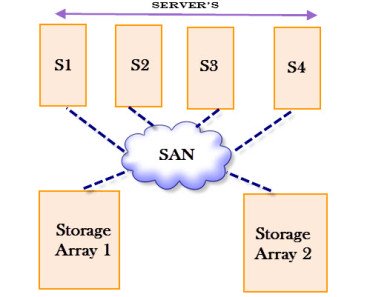Its been a while since we posted an article about Storage Area Network (SAN). As you already know SAN is a very popular and important term in the IT industry and we can’t even think of IT infrastructure without it. In today’s article, we will talk about the components of Storage Area Network (SAN) which will help you to understand SAN concepts more easily.
Components of Storage Area Network (SAN)
Without any delay, let’s see what are the basic components of Storage Area Network (SAN) and how they are further classified.
There are basically 3 components of SAN i.e. servers, network infrastructure, and storage. These parts can be further divided into the following vital elements: node ports, cabling, interconnecting devices (such as FC switches or hubs), storage arrays, and SAN management software.
Now let’s know more about these components.
Node Ports
Nodes are simply devices like hosts, storage and tape libraries that act as a source or destination for one or more nodes in a fibre channel.
Every node has 1 or more ports to communicate with other nodes in the system. These ports are integral components of a Host Bus Adapter (HBA) and the storage front-end adapters.
A port function in full-duplex data transmission mode with a transmit (Tx) link and a receive (Rx) link.
Cabling
Storage Area Network (SAN) realization or structure uses optical fiber cabling. As you must be knowing Optical fiber cables carry data in the form of light and there are 2 types of optical cables i.e. multi-mode optical cable and single-mode optical cable.
Multi-mode fiber (MMF) cable transfers multiple beams of light projected at different angles simultaneously onto the core of the cable whereas Single-mode fiber (SMF) carries a single ray of light projected at the center of the core.
Also, it is interesting to know that MMFs are generally used within data centers for shorter distance runs, while SMFs are used for longer distances.
Recommended Article: What is Network Attached Storage (NAS)?
Interconnect Devices
As the name suggests these devices are used for connection between hosts in the SAN environment and Hubs, switches and directors are the examples of interconnecting devices.
Hubs physically connect nodes in a logical loop or a physical star topology and are used as communication equipment in FC-AL applications.
Switches directly route data from 1 physical port to different one and are thus are more intelligent than hubs.
Directors works the same way as FC switches, but directors have higher port count and fault tolerance capacity. They are also larger than switches and are deployed for data center works.
Storage Arrays
The main aim of any SAN network is to provide storage resources to its host. SAN implementations supplement the standard features of storage arrays by providing high accessibility and redundancy, improved performance, business continuity, and multiple host connectivity.
The large storage capacities offered by modern storage arrays have been exploited in SAN environments for storage consolidation and centralization.
SAN Management Software
SAN management application package handles the interfaces between hosts, interconnect devices, and storage arrays.
SAN management software is very important as it allows the complete management of different resources from a single point and also gives the complete structure of the SAN environment.
It provides key management functions, as well as mapping of storage devices, switches, and servers, observance and generating alerts for discovered devices, and logical partitioning of the SAN, known as partitioning.
Additionally, the software package provides management of typical SAN elements like HBAs, storage elements, and interconnecting devices.
We hope you gained some knowledge from this article on “Components of Storage Area Network (SAN)” and would share this with your social network. If you have any thoughts and suggestions, please let us know through your comments. If you want to read more such articles, please do subscribe to our FREE newsletter.




![[9 Steps] Storage Migration from One Linux Server to Another Storage Migration from One Linux Server to Another](https://www.storagetutorials.com/storage/2015/08/xStorage-Migration-from-One-Linux-Server-to-Another-370x297.png.pagespeed.ic.Sfx0V-Zya_.png)